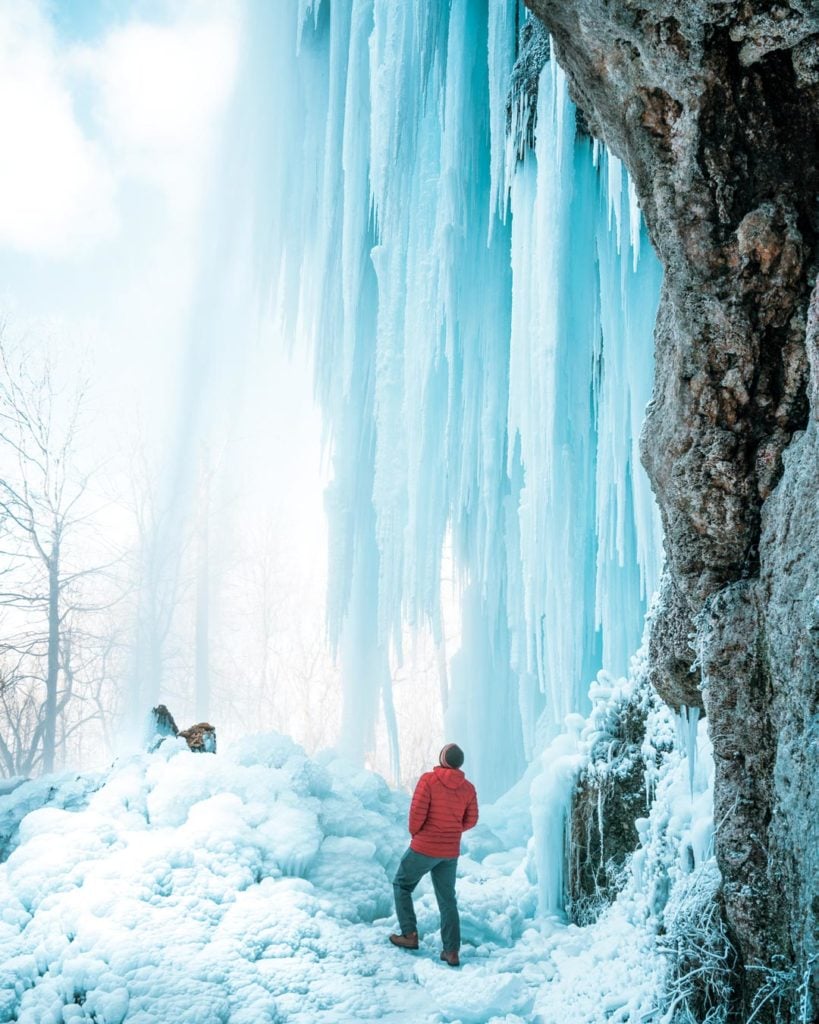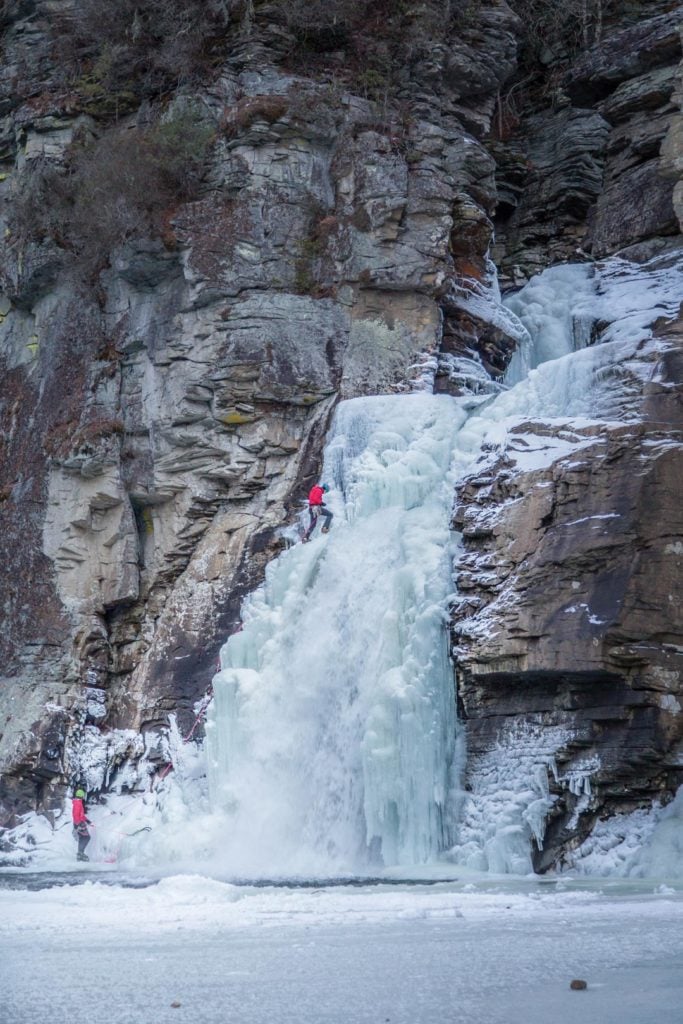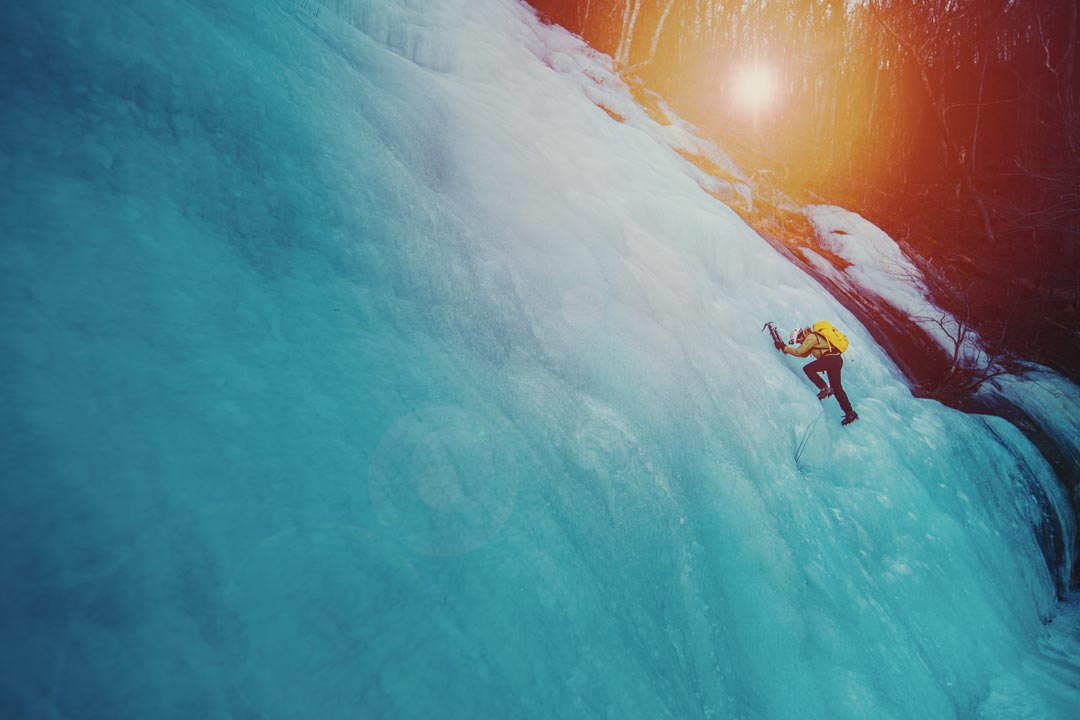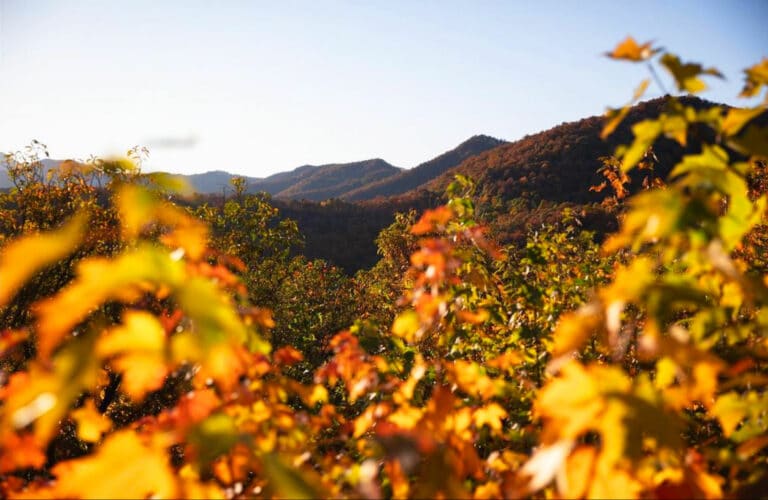The best kept secret in the Shenandoah
The Shenandoah ice crags are spoken about in hushed tones, with only the most trusted climbers charged with keeping these rare locations a secret.
“I think one of the fun things about ice climbing in this area is we kind of joke around that, yeah, we’re not going to tell you where it is,” said ice climber Grant Price. “It’s like hop in the car, the blindfolds are behind you.’”
There are a few places in Shenandoah National Park and the George Washington National Forest, like Crabtree Falls, Overall Run Falls, and Whiteoak Canyon, which are known in the region as potential locations for ice climbing.
But finding the really good stuff requires more legwork ahead of time, making climbers reluctant to spread that information around.
“There’s just not much ice,” Price said. “The joke is that the only ice in Virginia is usually in sweet tea.”
Without a definitive guidebook, Price said he spends a lot of time exploring different climbing areas during the warmer months for signs there might be ice in the winter. This might mean hiking for hours through the woods or looking for potential climbs on the side of the road.
When Price was in college, he noticed a drip on a road cut that had frozen over. Knowing that good climbing ice is rare in Southwest Virginia, he and a group of friends decided to test it out.
“We asked around before to see if anyone else had climbed it,” Price said. “Of course we wanted to claim that we’d done the first ascent.”
A barricade between the road and the cliff offered them about ten feet of protection. A concerned citizen driving by yelled at them to get down, but the college students shrugged it off and kept climbing.

“Next thing I know, I look over towards the university and there are blue lights coming over the hillside,” Price said. “We ended up with probably five police cars and the road being blocked off. They were moving traffic around because they were freaking out that the ice climb was going to fall down and hit a car.”
Price was mid-pitch and knew the ice screws he had placed in the fragile ice for protection would not hold his weight if he tried to lower off of them. In order to get down, he had to finish climbing all the way to the top of the cliff in order to rappel off a tree to the bottom.
“There was probably a remark in there about, ‘What’s the problem, officer? I’ve got my helmet on,’” Price said.
After making it safely to the bottom, Price and his friends got off easy with a warning. In the eight years Price has been ice climbing, he said opportunities like that are rare in the Mid-Atlantic but out there if you know what to look for.
Now Price works as the head guide for Blue Ridge Mountain Guides. During the winter, they lead ice climbing trips on the Blue Ridge Parkway when the weather allows it. They also provide guided trips to New Hampshire where winter conditions are more consistent.
“In Virginia, West Virginia, North Carolina, you’re going to get anywhere from a handful of days to maybe three weeks,” Price said. “During that time, it’s really just a matter of dropping everything and going. It’s not always going to be in on the weekends, you may have to go out mid-week.”
Such is the life of an ice climber in this region. The ice may be gone by the time you get out there if you are caught unprepared. The rarity of good climbing days is one of the reasons why these ice climbers are so reluctant to reveal the good stuff.
“Everyone really protects their ice in the Shenandoah because the Mid-Atlantic doesn’t get a lot of ice generally,” said climber Carol Clayton. “If we’re lucky enough to have something freeze enough to climb it, people keep their mouths shut.”
Clayton took up rock climbing four years ago at the age of 61. She found she had more free time in her schedule and always thought rock climbing looked cool.
“A lot of my friends were like, wait until you try ice climbing,” she said. “I’m like, oh, I’m not feeling that. But I was curious, and they were so enthusiastic.”
A year later, Clayton went on her first ice climbing trip with the Potomac Appalachian Trail Club- Mountaineering Section to the Adirondack Mountains in upstate New York. In the three years since she started ice climbing, most of Clayton’s trips have been to New York and Vermont where the ice is more reliable. The inconsistency of ice in the Mid-Atlantic makes it hard for her to get out more than once or twice a year.
But she heard whispers of a secret place in Shenandoah from her friends in the climbing community and wanted to be let into the club.
“Honestly, I just begged,” Clayton said. “I’m pretty sure there was pleading and probably a little bit of bribery.”
During a cold freeze last winter, some of her friends took her out to the Unicorn crag.
“I’m like, ‘What’s the Unicorn?’ They’re like, ‘I can’t tell you. And you can’t tell anyone,’” Clayon said. “I’m pretty sure I’ll never find this place again because once you pull off the road, there’s like an hour of hiking to get to it. So Shenandoah ice is a guarded secret.”
But Clayton said that all of the work that is put into finding a place to climb is worth it for the chance to embrace the feeling of this winter sport.
“When I climb and follow someone, I literally put my life in their hands,” she said. “And I do that every single time I climb. And, they put their life in my hands. So that alone makes it different from almost any sport I can think of.”
Most ice climbing in the Mid-Atlantic is water ice, a liquid flow like a frozen waterfall. The difficulty of the grade depends on the steepness of the pitch and the continuousness of the ice throughout the climb.
With water ice climbing, there are two main forms of ascensions, top rope and lead climbing. Top rope climbers are secured to an anchor, like a tree, at the top of the route with a belayer picking up the slack below.
In lead climbing, the first person up the route places ice screws as he or she ascends, climbing above his or her protection before placing the next screw.
Since she is still a beginner, Clayton does not expect to ever lead ice.
“Leading ice, you really have to know what you are doing,” Clayton said. “You have to be able to read the ice, you have to be able to read the weather because what you’re doing is putting ice screws into the ice, which is exactly what it sounds like. You’re screwing the thing into whatever ice you’re climbing and you’re clipping your rope to that. You’re hoping that you don’t fall and that the ice doesn’t break off. There’s a whole different set of problems with ice. That said, it’s also absolutely exhilarating.”
The small community of ice climbers in the Mid-Atlantic communicates through online groups about weather patterns and ice conditions in the area. Although multiple climbers brought up these mysterious crags and described these magical places, they refused to reveal the exact location.
“There are some well-known places, but there’s a lot more beyond that,” said Dustin Sanderson. “It’s not that we’re trying to be selfish, but sometimes it’s just nice to be productive. I’ll happily take someone there but I’m not going to blast it all over the Internet.”
Sanderson started rock climbing on and off when he was six and now runs Capital Climbing Guides out of D.C. His first ice climb was on a roadside cut in the mountains of North Georgia. He made his first ascent as the cars were whizzing by on the road below.
“The first time that I swung a tool into the ice, I was hooked,” Sanderson said. “We set up top ropes and ran laps all day and had a great time. After that, I was 100 percent hooked.”
He said there is something that draws him in about the quieter nature that winter brings out and “Not only the feel of the ice when you are swinging tools into it, but the way that you feel moving over the ice on an exceptionally cold day when the wind is really cranking and you can barely keep your fingers warm.”
If this does not sound like a pleasant way to spend your time, ice climbing probably is not the sport for you.
At one point, Sanderson offered ice climbing clinics in the winter but had to stop scheduling them because the conditions were never right and he usually had to cancel. He still offers to lead private climbs when there is ice.
“Really and truly, if you want to get into ice climbing, don’t try to learn it on your own,” Sanderson said. “Hire somebody that can teach you. Your experience is going to be that much better if you do that.”
When planning his trips, Sanderson watches the weather closely, looking for trends in the freeze/thaw cycle. The temperature, the wind, and where the sun is located in relation to the flow can change the properties of the climb.
“In the Mid Atlantic, it’s like a game,” Sanderson said. “It’s the thrill of the hunt, the thrill of the chase, especially over the past couple of years as I spent seeking out these areas that we suspect have potential flows. It’s a gamble. You go out and you might spend a whole day walking through the woods and you don’t find anything. But then there’s other days where you come around the side of the hill and you just see this area that opens up and it’s 100 meters wide of these beautiful pillars of ice that are just hanging down, waiting to be climbed.”

Waiting on Colder Weather
Gerardo Martinez learned to rock climb while stationed with the Marine Corps in sunny San Diego, Calif. When he moved to Maryland three years ago, he decided to try ice climbing as a way to stay active outside.
He started making trips to Minnesota, New Hampshire, and New York, embracing the thrill of the colder weather. A long way from the crags out west, Martinez got used to climbing the towering waterfalls and the below freezing temperatures that kept the flowing water unmoving. But he hasn’t tried ice climbing in the Mid-Atlantic yet.
“It honestly kind of sketches me out to go in such a warm climate,” he said.
While Martinez has heard of people who have ice climbed in the Mid-Atlantic the last few years, he is waiting for another storm like the blizzard that brought so much inclement weather over a decade ago.
“It’s been a lot warmer in the Mid-Atlantic than it has previously,” he said. “Around 2006, there was a giant snow dump and that was the year of ice climbing in the Mid-Atlantic just because there was so much ice and snow. If you look on Youtube, there’s a lot of videos of people ice climbing in the Shenandoah but they’re all from that year.”
Martinez owns and operates Triple Direct Leadership, using the outdoors to develop leadership and communication skills among individuals and groups. He typically organizes group outings like rock climbing and hiking.
“I have not had any clients that want to go out ice climbing,” Martinez said. “It’s a very unique sport because it is freezing. Generally, it takes a certain type of person.”
If he ever did lead an ice climbing trip, he would take them up north where the ice is a little more guaranteed and less dynamic. All of Martinez’s climbing partners are still up north, although he is looking for some adventurous souls in the Mid-Atlantic should the temperatures drop this winter.
“Not only are rock climbers rare, but ice climbers are even more rare.”








